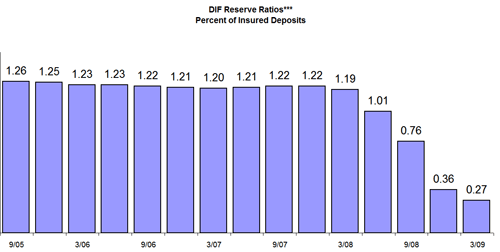FDIC Rightly Worries About Public Confidence
Due to the large number of bank failures during 2009 the FDIC Deposit Insurance Fund (DIF) has fallen to the lowest level since March 1993. Numerous headlines are screaming that the FDIC is bankrupt and that the DIF fund is depleted. Considering the perilous financial condition of the banking industry and the possibility of perhaps another 1,000 or more bank closings, the FDIC is probably not capable of fulfilling its mission without substantial loans from the US Treasury. (The last time this happened was in the early 1990s during the savings and loan crisis when the FDIC had to borrow $15 billion from the US Treasury.) This does not mean, however, that the upcoming FDIC Quarterly Banking Profile will report a negative balance in the DIF.
The FDIC has made it clear that they consider it important to maintain a positive DIF number to avoid causing a lack of confidence in the banking system by the public.
The FDIC believes that it is important that the fund not decline to a level that could undermine public confidence in federal deposit insurance. A fund balance and reserve ratio that are near zero or negative could create public confusion about the FDIC’s ability to move quickly to resolve problem institutions and protect insured depositors.
In addition, the FDIC has increased assessments on FDIC insured institutions to replenish the DIF fund and predicted that the DIF would remain positive in 2009.
May 22, 2009 – With the special assessment adopted today, the FDIC projects that the DIF will remain low but positive through 2009 and then begin to rise in 2010. However, Chairman Bair also cautioned that given the inherent uncertainty in these projections and the importance of maintaining a positive fund balance and reserve ratio, “it is probable that an additional special assessment will be necessary in the fourth quarter, although the amount of such a special assessment is uncertain.”
Even though the FDIC has significant authority to borrow from the Treasury to cover losses, a fund balance and reserve ratio that are near zero or negative could create public confusion about the FDIC’s ability to move quickly to resolve problem institutions and protect insured depositors. The FDIC views the Treasury line of credit as available to cover unforeseen losses, not as a source of financing projected losses.
The DIF Shell Game
So how does the FDIC manage to report a positive DIF when the March 31, 2009 balance was $13 billion and estimated FDIC losses on bank closing since March 31 total $19.3 billion? Determining the DIF balance is not a matter of simply subtracting the banking failure losses from the DIF fund. The FDIC uses accrual accounting to establish reserves against the DIF fund for estimated future losses.
For example, during 2008 the FDIC heavily reserved for anticipated future banking failures in 2009. The FDIC established provisions for losses of $41.8 billion compared to actual losses on 2008 bank closings of $17.9 billion. The reserve fund at March 31 had a balance of $28.5 billion against which the FDIC year to date losses since March 31 of $19.3 billion could be charged. This would still leave the FDIC a reserve balance for future banking failures of $9.2 billion.
In addition, the FDIC has imposed large assessment on FDIC insured banks to replenish the DIF fund. The assessments earned by the FDIC have increased steadily throughout 2008 as the banking crisis unfolded. In the first quarter of 2009, the FDIC collected assessments of $2.6 billion to rebuild the DIF fund. This compares to total assessments for all of 2008 of $2.965 billion and only $643 million in 2007.
In summary, if the FDIC offsets its losses against previously established reserves, and collects an additional $3 billion in assessments, the FDIC could actually report an increase in the DIF fund to approximately $16 billion. My guess is that the FDIC will only use a portion of the reserve balance, and report a DIF positive balance in the range of $10 to $13 billion when the Quarterly Banking Profile is released. It’s all about confidence and an uneducated stupid public – the DIF balance of around $20 billion allegedly “protects” over $6 trillion in deposits! The only thing that would expose this “confidence game” is if the financial results for the banking industry come in much worse than the last quarter. Stay tuned.

DIF
Disclosures: None
Oh don’t worry the economic collapse just got a boost from news out of China and Hong Kong, and a breakout in gold! I’ve been writing about this for a while now at my blog.
Nice blog though. I would appreciate any comments you leave on my posts.